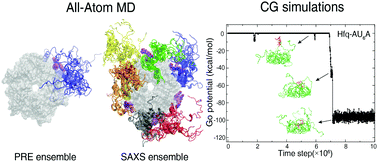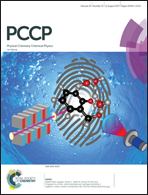Structural and dynamic properties of the C-terminal region of the Escherichia coli RNA chaperone Hfq: integrative experimental and computational studies†
Abstract
In Escherichia coli, hexameric Hfq is an important RNA chaperone that facilitates small RNA-mediated post-transcriptional regulation. The Hfq monomer consists of an evolutionarily conserved Sm domain (residues 1–65) and a flexible C-terminal region (residues 66–102). It has been recognized that the existence of the C-terminal region is important for the function of Hfq, but its detailed structural and dynamic properties remain elusive due to its disordered nature. In this work, using integrative experimental techniques, such as nuclear magnetic resonance spectroscopy and small-angle X-ray scattering, as well as multi-scale computational simulations, new insights into the structure and dynamics of the C-terminal region in the context of the Hfq hexamer are provided. Although the C-terminal region is intrinsically disordered, some residues (83–86) are motionally restricted. The hexameric core may affect the secondary structure propensity of the C-terminal region, due to transient interactions between them. The residues at the rim and the proximal side of the core have significantly more transient contacts with the C-terminal region than those residues at the distal side, which may facilitate the function of the C-terminal region in the release of double-stranded RNAs and the cycling of small non-coding RNAs. Structure ensembles constructed by fitting the experimental data also support that the C-terminal region prefers to locate at the proximal side. From multi-scale simulations, we propose that the C-terminal region may play a dual role of steric effect (especially at the proximal side) and recruitment (at the both sides) in the binding process of RNA substrates. Interestingly, we have found that these motionally restricted residues may serve as important binding sites for the incoming RNAs that is probably driven by favorable electrostatic interactions. These integrative studies may aid in our understanding of the functional role of the C-terminal region of Hfq.



 Please wait while we load your content...
Please wait while we load your content...